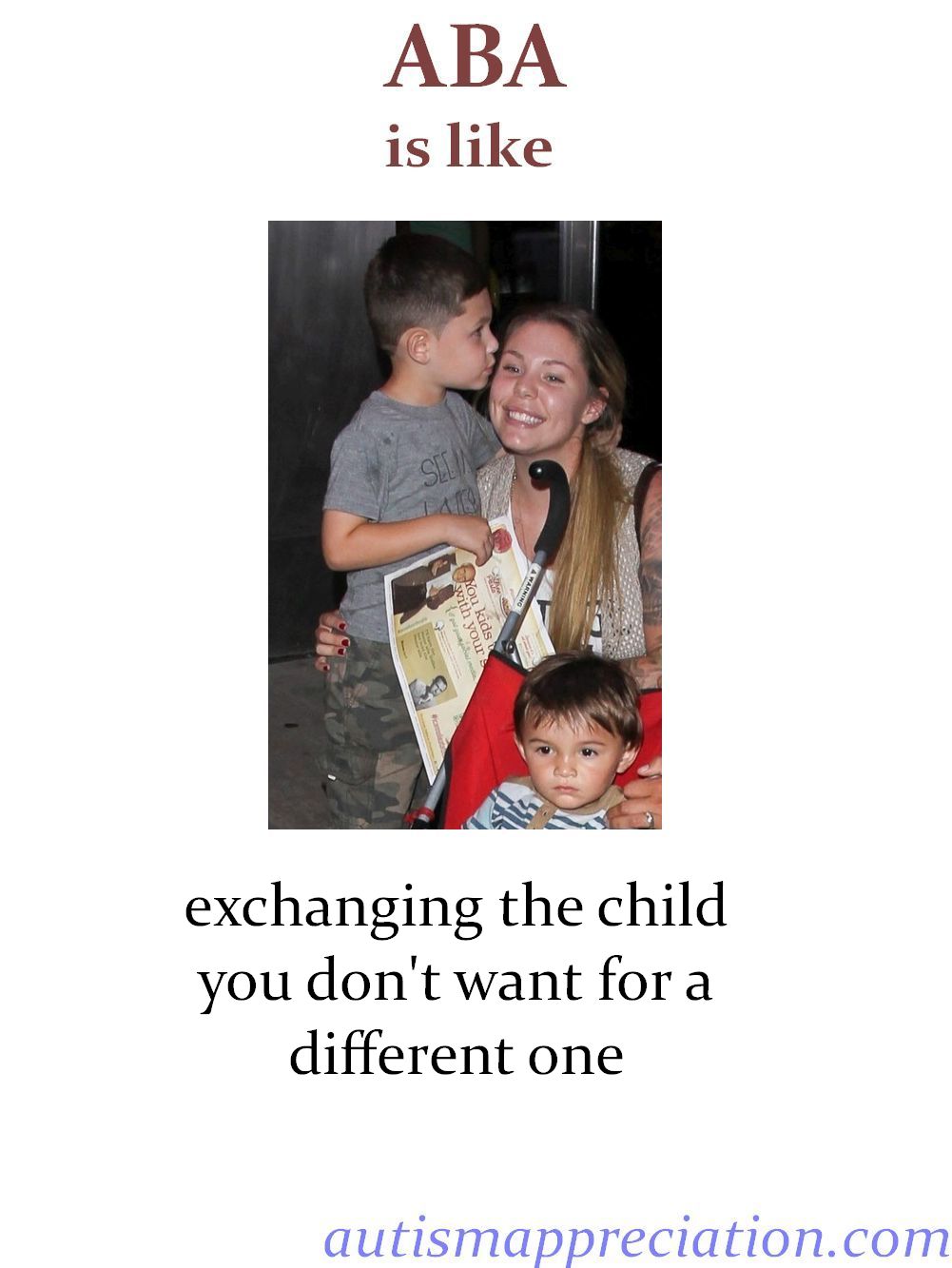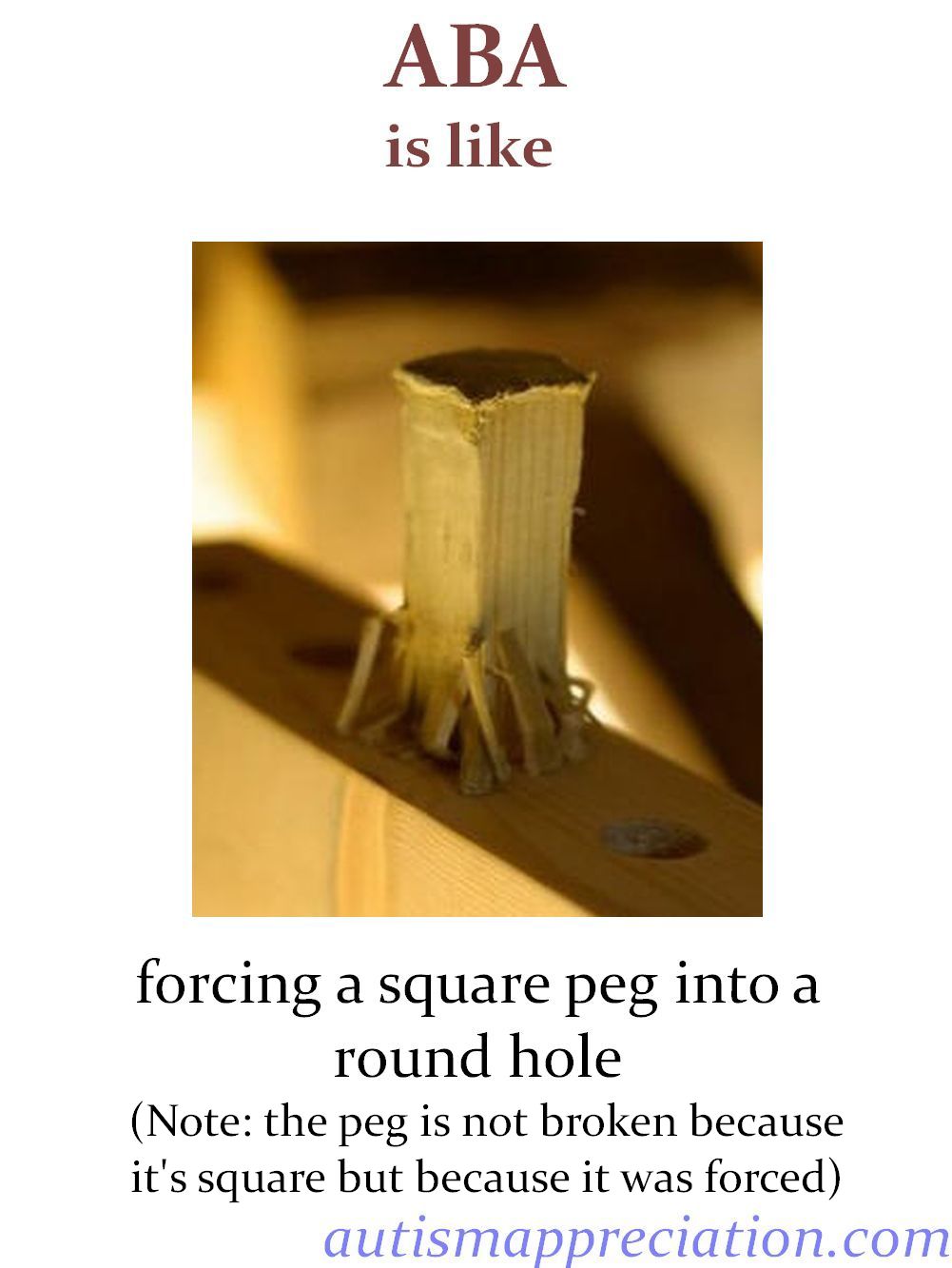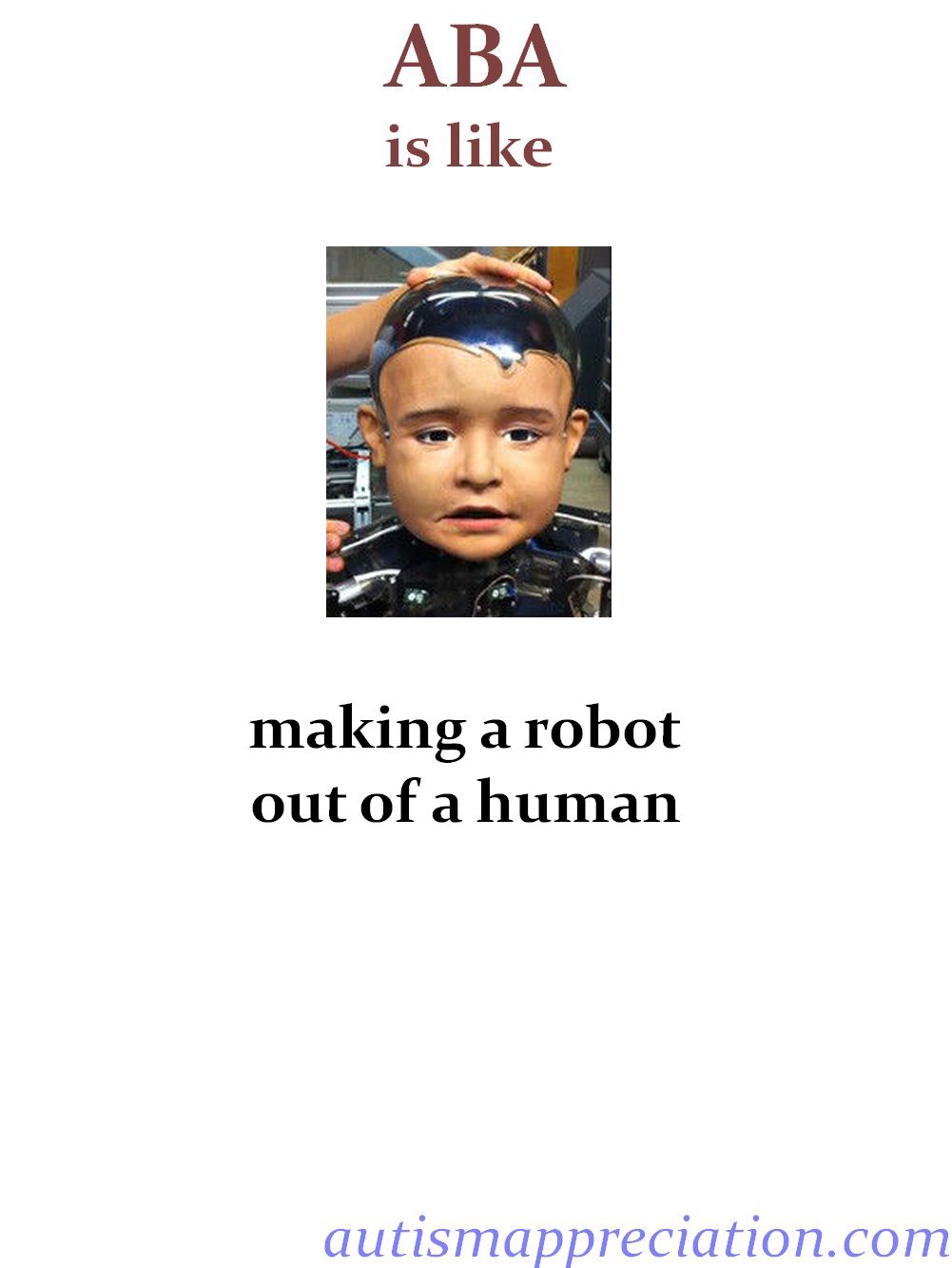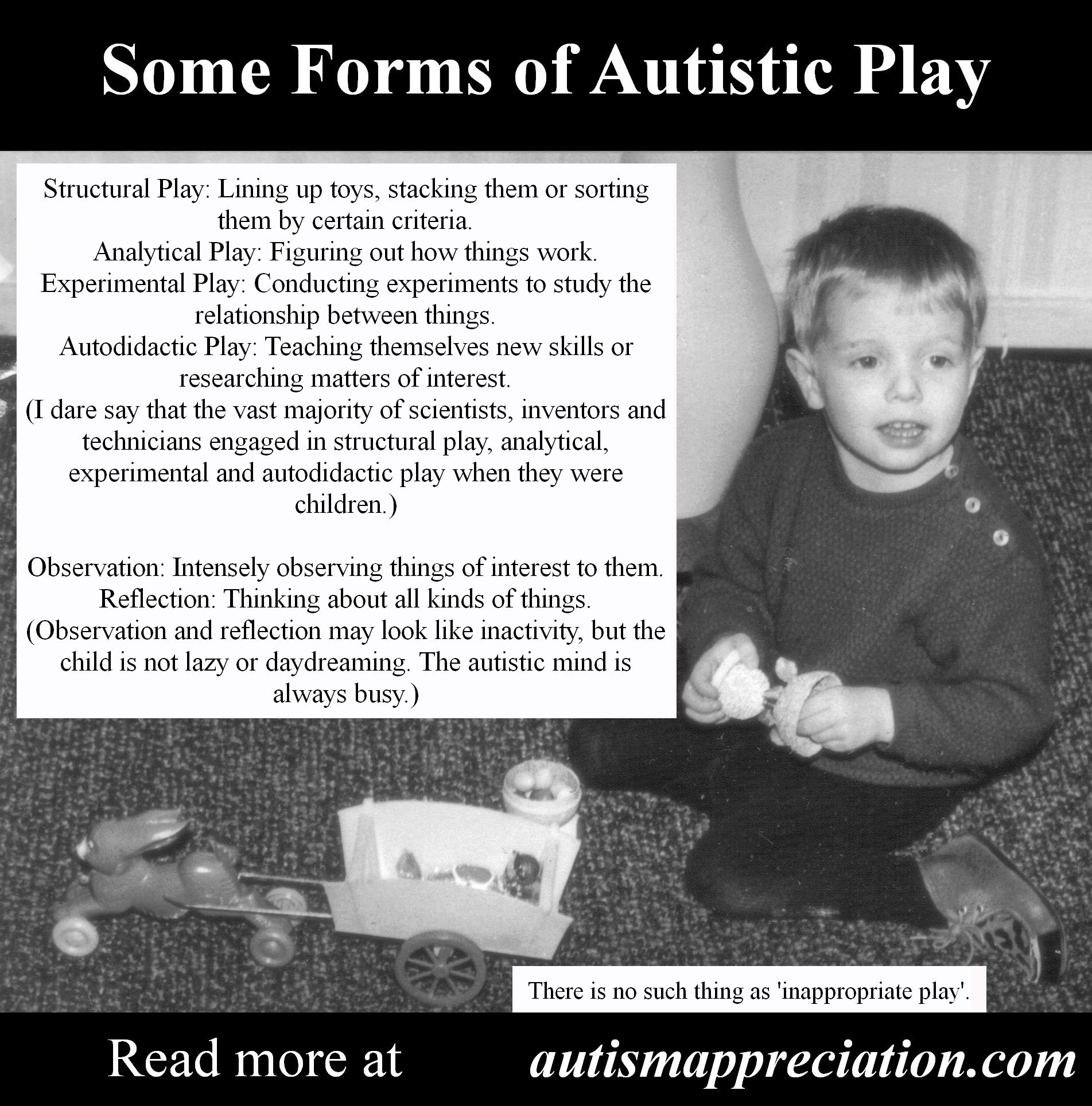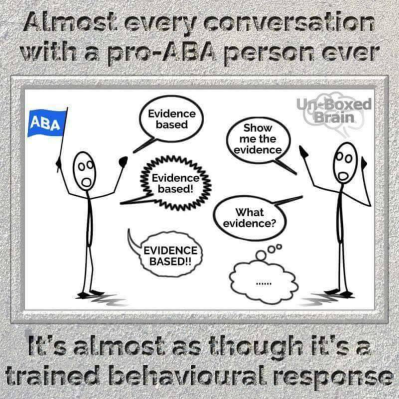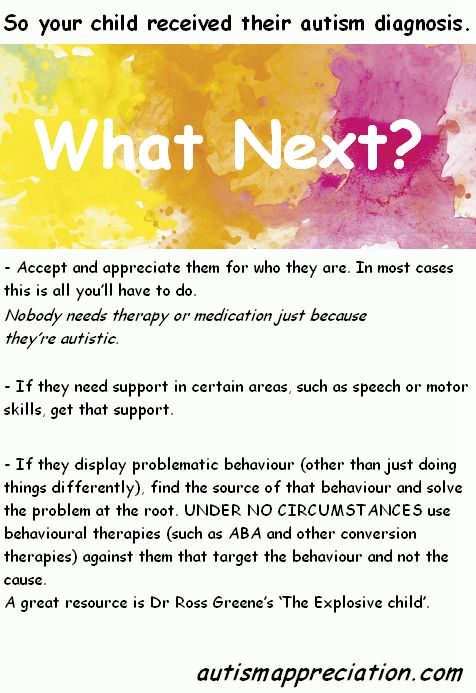
Read more on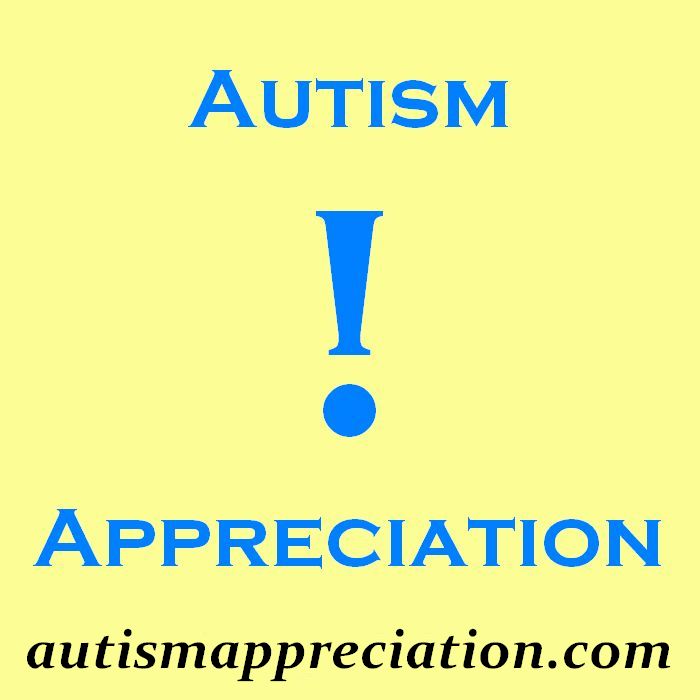
|
Tweet
|
Applied Behaviour Analysis (ABA) is not a ‘cure’ for autism, it is a personality-altering conversion therapy camouflaging the real person at a terrible cost. Problematic and undesired behaviours have causes; ABA intends to change these behaviours without addressing the causes.
As a concerned parent you want what’s best for your child, and a lot of professionals and other parents will have you believe that using ABA against your child is the solution to all problems. It is not!
Imagine you were a child born into a world where everything, including writing, is done with the left foot, every sentence has to begin with ‘Simon says’, and breathing through the nose is considered rude.
You will find that the majority of parents who subjected their autistic children to ABA (which has also been used to reprogramme homosexuals, today under the name ‘conversion therapy’) swear by it while the majority of autistic individuals who were exposed to it absolutely abhor it. The reason for this is perfectly simple: while ABA makes life easier for parents and caregivers (at least for the time being) by getting rid of undesirable behaviours and enabling them to pass their child off as ‘more normal’, the child is put under an unbearable pressure to conform, perform and obey without any consideration for their feelings, needs, desires, abilities and emotional safety.
A former ABA therapist states that she ‘repeatedly found that [she] had to make a choice between doing the ABA and respecting the child.’
Rather than tapping into the enormous potential of the autistic mind, it forces the child to copy the behaviour of non-autistic persons. Just like forcing a left-handed person (who might be a gifted painter or sculptor if allowed to use their stronger hand) to use their right hand doesn’t make them right-handed, and like training a fish to climb a tree doesn’t make them a squirrel, forcing your child to copy non-autistic behaviour will not make them non-autistic, and it will induce feelings of incompetence, inferiority and self-loathing; had the likes of Leonardo da Vinci or Albert Einstein been subjected to ABA, we wouldn't know their names today.
One of the pioneers of ABA was Ivar Lovaas who later applied the same methods in his gay conversion therapy.
ABA comes in many different forms, from short friendly sessions to the electrotorture at the Judge Rotenberg Center, and a lot of well-meaning advocates claim that their own version is more positive, more accepting and more respectful towards the child than others. I will not go into details about the significantly different approaches because the problem is the very concept of ABA itself: the conditioning of an individual.
Pairing, i.e. bonding with the child in order to coerce them into behaviours they are uncomfortable with, is one of the central elements of ABA. In other contexts this technique is known as grooming.
ABA is designed to make the child act in a socially acceptable manner so they can be presented as ‘normal’ as possible. This provides parents and caregivers with great relief and convinces them that their child progressed. But getting the child to function in the desired way comes at a price.
Firstly, it teaches the child that they are broken and need to be fixed, like an object in a repair shop. It takes away the child’s self-esteem, their personality, even their intellectual and physical autonomy and replaces all these with self-hatred for being such a burden. After they have been forced into submission and programmed, they function like a mindless robot without any sense of identity.
Secondly, ABA only addresses the symptoms, not the underlying problems. The causes, such as sensory overload, remain and build up which in the long run can cause major meltdowns and serious mental health issues. Furthermore, the heightened pressure, anxiety and helplessness experienced during the therapy very often lead to severe Posttraumatic Stress Disorder (PTSD). There is also a plausible case for ABA causing Obsessive-Compulsive Disorder (OCD) for the same reasons, as well as for depression and regressive autism as a result. (‘Could it be that sudden major regression is common in ABA programs rather than common in autism? We find this premise to be consistent with our training in depth psychology. According to Sigmund Freud, regression takes place in the face of acute trauma and overwhelming anxiety. We posit that behavioral modification can be a springboard to many serious maladies and maladjustments.’)
Thirdly, the child is taught that their value depends on their obedience and that their appreciation is subject to their subservience. In many cases they are also denied access to things of interest (and sometimes even basic needs such as food) unless they are compliant.
Fourthly, it destroys the intellectual potential of the child by teaching them that their way of thinking is incorrect. This affects not only the child but also society since it prevents the emergence of original thinkers.
While this type of treatment would be demeaning for any child (or adult, for that matter), it is even more detrimental to autistics because of their increased sense of individuality and identity.
Besides all this, learning that they have no right to control their own minds and bodies leaves the child vulnerable to all kinds of mental and physical abuse since they have no way of distinguishing between authorised and unauthorised abuse.
Many defensive parents will claim, ‘But my child enjoys the therapy!’ – There can be several reasons why it may look that way, such as having access to objects of interest that are usually withheld from them, trying to please someone who has unlimited authority over them, or the even more distressing atmosphere they’re exposed to if they don’t act happy.
Furthermore, it’s a sad fact that a frequently repeated lie is eventually believed by most. People promoting ABA more often than not throw the term ‘evidence-based’ into the discussion, even though the vast majority of studies in support of ABA don’t use control groups to compare the results with, which is quite an unscientific approach. And even when it comes to the few controlled studies, according to a scientific review, ‘there is not enough evidence to corroborate ABA's preponderance over other alternatives.’ (Also, the vast majority of pro-ABA studies are carried out by researchers who are part of the ABA industry without declaring a conflict of interest.)
ABA is often compared to dog training. However, this professional dog trainer points out that dog training is different from ABA since the feelings and needs of the animal are being taken into consideration. Regarding ABA she concludes, ‘I wouldn’t treat a dog that way.’
In conclusion, subjecting your autistic child to this dehumanising treatment will cause them tremendous suffering and irreparable mental damage.
Then what is the alternative, you ask?
Your child is autistic. Your child will always be autistic. Even if they learn to copy ‘normal’ people, to follow prompts like a trained dog, to suppress their identities and emotions in order to fit in: your child will always be autistic.
Accept them for who they are instead of trying to break them. If you think about it, who gets hurt if they stim, don’t make eye contact or refuse to hug on command?
And if some of their behaviours cause injury to themselves or others, find out the cause for this behaviour and solve the problem at the root.
Aggressive behaviour is usually the result of the environment. A successful way of dealing with it is The Explosive Child, a cooperative approach by Dr Ross Greene.
After all, isn’t your child’s welfare and happiness more important than your desire for them to appear ‘normal’? Focus on their strengths and abilities, encourage their interests and draw on them for teaching purposes, explain to them why they have to perform certain chores, pay attention to their non-verbal communication, avoid pressure and situations that may cause sensory overload, and I assure you that if you learn to appreciate your child’s autism, so will they.
Study: Evidence of increased PTSD symptoms in autistics exposed to ABA
Applied Behavior Analysis and Autism Spectrum: Literature Review
Why I left ABA, by a former ABA therapist on the dehumanising practice
I Abused Children for a Living, by another former ABA therapist
Is ABA Really “Dog Training for Children”? by a professional dog trainer
An Open Letter to Families Considering Intensive Behavioral Therapy, by parents whose child developed PTSD as a result of ABA
Tackling That Troublesome Issue of ABA and Ethics, from Emma's Hope Book
Kennedy Institute of Ethics: Ethical Concerns with Applied Behavior Analysis
Are there any adult autistics who are willing to share their personal experience with ABA therapy? is a Reddit post in which ABA-damaged adults discuss their traumatic experiences
ABA Therapy is not like Typical Parenting (the difference between intense behavior therapy and more typical forms of rewards and punishments)
Blog Post on Possible Reasons for Problematic Behaviour
Ask an Autistic #5 - What is ABA? (Video by Amythest Schaber)
Invisible Abuse: ABA and the things only autistic people can see
Analysing Responses to ABA Critiques
What an ABA session looks like (an autistic adult remembers his ABA sessions)
On Hurling Myself into Traffic to Get Out of ABA Therapy
Non-Speaking Autists’ Thoughts on ABA
Why Professional Behavior Analysts are Leaving the Field
ABA Discussion Page on Facebook
ABA Funding Withdrawn by German Charity
US Government Reports that ABA Doesn't Work
ABA Sonnet
Your mum is very distressed because you are so different from other children, and in an attempt to make you fit in better she gets a therapist for you.
The therapist sits down beside you and gives you a pen and paper.
‘Simon says: can you write any letter?’ he asks you.
Silly question, you think, I could write a novel if I were allowed to use my hand. You reach for the pen, but the therapist holds your hand down with his foot and reprimands you, ‘Simon says: what do we write with?’
You finally give in and desperately try to get a hold of the pen with your left foot. After minutes of struggling, almost succeeding but then dropping it again, you eventually get a grip on the pen.
‘Simon says: good girl/boy!’ the therapist remarks and gives you a dandelion leaf. You don’t know what the story with the leaves is, but since they are very prestigious, you are proud you got one.
You now proceed with your attempt at writing a letter. An 'O' would probably be the easiest one, and even though you fail to complete the circle properly, the therapist exclaims, ‘Simon says: excellent! You’re making great progress!’ before presenting you with another leaf.
You say, ‘I have to go to the toilet.’
‘Simon says: I can’t hear you.’
‘I really have to go to the toilet,’ you insist.
‘Simon says: nobody takes notice of what you say. Do you know why?’
‘Simon says: I have to go to the toilet NOW!’
‘Simon says: that’s better,’ your therapist replies and takes out another dandelion leaf while you are waiting for permission to go. Your anxiety level has reached a new height, and you breathe heavily through your nose.
With a disgusted frown your therapist pinches your nose and reminds you, ‘Simon says: how do we breathe?’
This is Applied Behaviour Analysis.
The link between ABA and PTSD was proved in a study in 2018 which found that autistic persons exposed to ABA are 86% more likely to develop PTSD (41% in adults and 130% in children) than those who were not.
Because ABA takes away their self-esteem, and since studies frequently mention camouflaging as a high-risk factor regarding the enormous suicide rate of autistic people, it is most likely that former ABA victims make up the majority of cases.
In a highly recommendable article on the subject the author writes, ‘People who can’t say no, can’t say yes meaningfully. Looking happy isn’t meaningful if you’re rewarded for affecting happiness and punished for looking visibly distressed. Making the best of a bad situation isn’t consent.’
Further reading:
If you would like to see autistic children protected from conversion therapies please sign this petition.
MORE ON AUTISM

